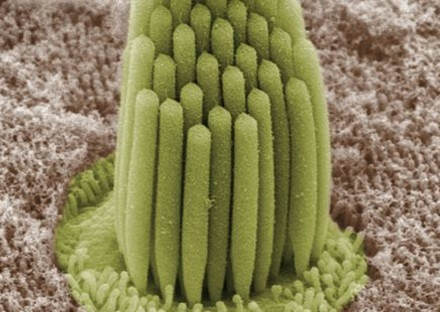Cochlea: what is it, parts, functions and associated pathologies
Hearing, as its name suggests, is a term that encompasses the physiological processes that give the human being the ability to hear and relate to his environment based on this sense essential.
In very general terms, the hearing process can be distinguished in the following events: the ear receives the Sound waves, which are transmitted through the ear canal to the eardrum, which produces a series of vibrations. These reach the chain of ossicles, responsible for transmitting them to the inner ear through the oval window.
It is at this point where it comes into play the cochlea or snail, an essential part of the mammalian auditory system. Immerse yourself with us in the world of auditory anatomy, because today we tell you what the cochlea is, its parts, the functions it performs and what happens when it fails.
- Related article: "The 10 parts of the ear and the process of receiving sound"
What is the cochlea?
The cochlea is a spirally wound tube-like structure located in the inner ear, more specifically, in the temporal bone
. In general, this structure is about 34 millimeters long in an adult individual and, it should be noted, that inside it is the organ of Corti.
The organ of Corti is essential to understand the hearing process, as it is made up of a series of sensory cells (about 16,000) arranged in a row, specifically called "cells ciliated ”. These are the last ones in charge of "interpreting" the sound waves received by the external ear, as they transform them into electrical impulses that reach the auditory nerve, and from there, to the brain.
Parts of the cochlea
It is not yet time to describe the complex process that involves the integration of sounds at the cerebral level, since we still have a lot of cloth to cut in an anatomical field. In the first instance, we can say that the cochlea is made up of three essential parts. We describe each of them:
- Columella: central cone that houses the cochlear nerve.
- Reticular lamina: surrounds the columella.
- Spiral sheet: on which the inner wall of the reticular sheet rests.
It should be noted that, beyond a description of the tissues observed in a structural cross-section, more information provides us with a look at the three longitudinal chambers that make up the cochlea. These are the following:
- Tympanic ramp.
- Vestibular ramp.
- Average ramp.
The scala tympani and scala vestibuli contain perilymph (a serum-like fluid) and are communicate with each other through a small conduit called a helicotreme, located at the end of the cochlea. This allows communication and perilymph fluid between both structures. For its part, the middle ramp or cochlear duct is located between the vestibular and tympanic ramps and contains the endolymph. This structure presents a fairly complex anatomy in terms of terminology, which is why we will limit ourselves to to say that it is triangular and that, finally, between the scala tympani and the scala media is the already named organ of Corti.
Beyond this conglomerate, we must also highlight that these three chambers (scala tympani, vestibular and middle) are separated by two types of membrane: Reissner's membrane and basilar membrane.
Reissner's membrane separates the buccal and medial ramp, and its function is to preserve the endolymph in the cochlear duct, where it must remain. On the other hand, the basilar membrane is responsible for separating the middle and tympanic ramps. Its function, even so, is not so easy to explain, since the organ of Corti rests on it. Let's focus a little more on this very special membrane.
The role of the basilar membrane in hearing
First of all, it is necessary to emphasize that the response of the basilar membrane to certain sounds will be affected by their mechanical properties, which vary progressively from the base to the apex.
At the end closest to the oval window and the eardrum, this membrane has a stiffer, thicker and narrower morphology. Therefore, its resonance frequency is high for high tones. On the other hand, at the distal end, the basilar membrane is wider, softer, and more flexible, which causes the response to be better at low frequencies. As a curious fact, we can say that this structure produces a decrease of ten thousand times in its stiffness from the proximal to the distal end.
At each point of this special membrane there is a tuning, and the place where the greatest displacement occurs at a certain frequency is called the “characteristic frequency”. In other words, the range of resonance frequencies available in the basement membrane determines the hearing capacity of the human being, which is between 20 Hz-20,000 Hz.
The organ of Corti
The basilar membrane analyzes frequencies, but is the organ of Corti in charge of decoding this information and sending it to the brain. Let's start from the beginning to understand how it works.
We are again at the base of the inner ear: when a vibration is transmitted through the ossicles of the middle ear to the oval window, there is a pressure difference between the vestibular and tympanic. Consequently, the endolymph present in the median ramp shifts, producing a traveling wave that propagates along the basilar membrane.
The displacements of the basilar membrane make the hair cells (remember that they are the ones that make up the organ of Corti) to move in relation to it and, thanks to this, they are excited or inhibited depending on the direction of movement. Depending on the region of the basilar membrane that oscillates with the greatest amplitude according to the perceived sound, different portions of the hair cells that make up the organ of Corti will be activated.
Finally, hair cells produce certain chemical components that are translated into nerve signals, the which will be sent first to the acoustic nerve and then to the auditory nerve (also known as the cranial nerve VIII). Of course, we are facing a journey of very complex understanding, but we can summarize it in the following concept: the basilar membrane "vibrates" more in one point or another depending on the type of sound, and the excited cells translate this signal, which ends up reaching the brain through a series of nerves.
- You may be interested in: "Organ of Corti: characteristics of this part of the inner ear"
What happens when the cochlea fails?
Notably hair cells do not regenerate, that is, when an individual is injured, he or she loses hearing irremediably. Human beings take our senses for granted until we lose them and, therefore, the Organization World Health Organization (WHO) helps us to contextualize a bit what hearing loss entails at the level general:
- More than 460 million people in the world have a disabling hearing loss.
- It is estimated that by 2050 this value will rise to 900 million, that is, one in 10 people will have hearing impairment.
- 1.1 billion young people around the world are at risk of hearing loss from exposure to excessive noise in recreational settings.
A major factor promoting hearing loss (hearing loss) is chronic exposure to loud sounds. In these cases, the hair cells already described or the nerves that supply them are damaged at some point, which induces the patient to hear the sound distorted or, for example, it is easier to interpret frequencies that other
Finally, it is also essential to note that age-related hearing loss (presbycusis) is, unfortunately, completely normal. This process It is observed in almost 80% of the elderly people over 75 years of age, and is produced by a deterioration of the structures located in the inner ear or the auditory nerve itself.
Summary
As we have seen in these lines, the cochlea had many more secrets for us than we could imagine. From a complex morphology to the basilar membrane and the organ of Corti, one concept is clear to us: hearing is a true work of engineering. Maybe all this information will make us think twice the next time we turn up the volume of the headphones to the maximum, right?
Bibliographic references:
- What is the cochlea? Audifon, hearing centers. Picked up on November 12 in https://audifon.es/que-es/c/coclea-o-caracol/
- Hearing and the Cochlea, Medlineplus.gov. Picked up on November 12 in https://medlineplus.gov/spanish/ency/anatomyvideos/000063.htm
- Cochlea, generalities: journey to the world of hearing, cochlea.eu. Picked up on November 12 in http://www.cochlea.eu/es/coclea
- Cochlea, vestib.org. Picked up on November 12 in https://www.vestib.org/es/coclea.html
- Deafness, World Health Organization (WHO). Picked up on November 12 in https://www.who.int/es/news-room/fact-sheets/detail/deafness-and-hearing-loss
- Soto, E., Vega, R., Chávez, H., & Ortega, A. (2003). Physiology of hearing: the cochlea. Autonomous University of Puebla. Recovered from: http://www. physiology. buap. mx / online / DrSotoE / COCLEA, 202003.
- Terreros, G., Wipe, B., León, A., & Délano, P. H. (2013). From the auditory cortex to the cochlea: Progress in the auditory efferent system. Journal of Otolaryngology and Head and Neck Surgery, 73 (2), 174-188.


